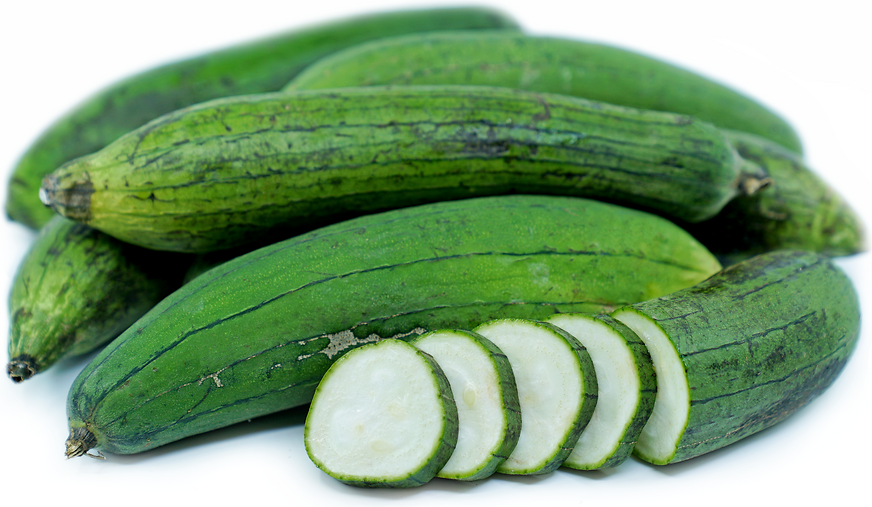


Sponge Gourd
Estimated Inventory, lb : 0
Description/Taste
The Sponge gourd is a cylindrical fruit that grows on a climbing, herbaceous vine. It has a smooth, green skin when young, and may feature ridges or ridge lines that run across the skin of the fruit. The Sponge gourd grows up to 60 centimeters long, but is harvested as a vegetable when it is young and tender, at around 12 centimeters in length. The Sponge gourd contains many seeds, which can be around 1.5 centimeters in length. The seeds are also edible but are usually removed before the flesh is eaten. The interior flesh of the Sponge gourd is smooth and creamy-white. Sponge gourd has a mild, zucchini-like sweet taste and a silky texture. Mature fruits are not tasty, being fibrous, bitter and brown.
Seasons/Availability
Sponge gourd is grown year-round and has a peak season in the summer months.
Current Facts
The Sponge gourd, also called the Luffa or Loofah gourd, is a member of the Curcurbitaceae (cucumber) family. The name Sponge gourd generally refers to the fruit of two species –L. cylindrica, which is smooth-skinned with faint ridge lines; and L. acutangula, which has prominent ridges and is known as Angled gourd. The Sponge gourd is a fast-growing plant found in tropical and subtropical regions of the world. The fruit may grow as much as 3.5 centimeters a day. Young Sponge gourds have a tender skin that tends to break easily. To avoid damage, the fruit is cut from the vine, rather than pulled. The dried fibers of mature Sponge gourd are used to make sponges. These are used to make loofahs to exfoliate the skin; or to make scrubbing sponges for kitchens and bathrooms.
Nutritional Value
Sponge gourd is loaded with nutrients such as dietary fiber, vitamin C, vitamin A, riboflavin, zinc, thiamine, iron and magnesium. The Sponge gourd fruit has been found to have antioxidant, antibacterial and antifungal properties.
Applications
Only the young fruit of the Sponge gourd is used in culinary applications. Young Sponge gourds may be eaten raw, like cucumbers, or cooked as a vegetable. Sponge gourd may be used in dishes that call for squash, zucchini or okra. As its name suggests, Sponge gourd also soaks up the flavors of the accompanying spices and ingredients. Sponge gourd can be used in soups, curries, chutneys and stir-fries. The Sponge gourd is good simply steamed and finished with a drizzle of sesame oil and soy sauce, or with browned garlic and slices of chili pepper for flavor. It may also be stuffed with meat, such as pork, and steamed. Sponge gourd can eaten raw – it can be cut into slices and used in salads. The fruit is best consumed as soon as it is bought or harvested. Sponge gourd can be stored in the refrigerator for 4 to 5 days.
Ethnic/Cultural Info
The Sponge gourd is used in various cuisines and traditional medicines. In the warm, southern areas of Japan, the fruit is used as a vegetable. There, it is known as Hechima and is found in the regional dishes of Okinawa and Kyushu. In South East Asia, it is commonly stir-fried with eggs, along with dried shrimp, chillies and garlic. In India, the Sponge gourd may be used as a vegetable in curries, chutneys and stir-fries, and is also eaten as a delicious deep-fried snack called bhaji. The Sponge gourd is said to be good for various health issues – in Indian Ayurvedic medicine, the leaves and fruit of the Sponge gourd are used as a blood purifier, and to treat skin diseases, swellings and intestinal worms. The fruit is also taken to help treat imbalances in the body. In Africa, the whole fruit of the Sponge gourd is used to help prevent constipation. In Paraguay, the tough fibers of mature Sponge gourds are used along with other vegetable matter and recycled plastic to make panels. These are used for home construction, and to create furniture.
Geography/History
The exact origins of the Sponge gourd are not known, but the plant is native to Asia, where it grows naturally in areas such as India, the Philippines and Myanmar. It was grown commercially in Japan in 1890, and was brought to the American tropics from there. Today, the Sponge gourd is found in most tropical and subtropical regions of the world, such as in Africa, South and Central America and growing widely throughout Asia, especially in China and Japan.
Recipe Ideas
Recipes that include Sponge Gourd. One




